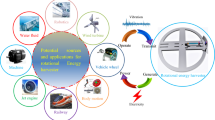Abstract
In order to broaden the operating frequency bandwidth of the vibration energy harvester (VEH), a novel frequency self-tuning VEH is proposed for rotating applications. Under the rotating excitation, the proposed VEH can simultaneously adjust two parameters that affect the resonant frequency by centrifugal force, which is the key to realize frequency self-matching of the VEH in a certain frequency range. The two parameters are the axial force and effective length of the piezoelectric beam. A frequency tuning mass was designed to effectively adjust the axial force of the piezoelectric beam, and a nonlinear spring was designed to accurately control the effective length of the piezoelectric beam. The proposed VEH was simulated with ANSYS. The simulation results show that there is only one frequency matching point in a certain rotation frequency range when the centrifugal force only changes the axial force of the piezoelectric beam, which is the reason why the reported self-tuning VEH can not achieve frequency self-matching within a certain frequency range. When the centrifugal force simultaneously changes the axial force and the effective length of the piezoelectric beam, the frequency self-matching can be realized in a certain frequency range instead of only one frequency point. Simulation data analysis shows that the proposed VEH can achieve frequency self-matching in the range of 10–20 Hz through easy spring design.







Similar content being viewed by others
References
Adachi M, Akishige Y, Asahi T, Deguchi K, Gesi K, Hasebe K, Hikita T, Ikeda T, Iwata Y, Komukae M, Mitsui T, Nakamura E, Nakatani N, Okuyama M, Osaka T, Sakai A, Sawaguchi E, Shiozaki Y, Takenaka T, Toyoda K, Tsukamoto T, Yagi T (2001) Pb(Ti<1-x>Zr<x>)O3 (PZT), 1C-a63. In: Shiozaki Y, Nakamura E, Mitsui T (eds) Oxides. Landolt-Börnstein - Group III Condensed Matter, vol 36A1. Springer. https://doi.org/10.1007/10426842_173. https://materials.springer.com/lb/docs/sm_lbs_978-3-540-31349-6_173. Accessed 21 Oct 2020
Al-Ashtari W, Hunstig M, Hemsel T, Sextro W (2012) Frequency tuning of piezoelectric energy harvesters by magnetic force. Smart Mater Struct 21(3):035019
Alevras P, Theodossiades S (2019) Vibration energy harvester for variable speed rotor applications using passively self-tuned beams. J Sound Vib 444:176–196
Gu L, Livermore C (2010) Passive self-tuning energy harvester for extracting energy from rotational motion. Appl Phys Lett 97(8):081904
Hsu J, Tseng C, Chen Y (2014) Analysis and experiment of self-frequency-tuning piezoelectric energy harvesters for rotational motion. Smart Mater Struct 23(7):075013
Kim H, Tai WC, Parker J, Zuo L (2019) Self-tuning stochastic resonance energy harvesting for rotating systems under modulated noise and its application to smart tires. Mech Syst Signal Process 122:769–785
Maamer B, Boughamoura A, Fath El-Bab AMR, Francis LA, Tounsi F (2019) A review on design improvements and techniques for mechanical energy harvesting using piezoelectric and electromagnetic schemes. Energy Convers Manag 199(111):973. https://doi.org/10.1016/j.enconman.2019.111973
Paradiso JA, Starner T (2005) Energy scavenging for mobile and wireless electronics. IEEE Pervasive Comput 4(1):18–27
Roundy S, Tola J (2014) Energy harvester for rotating environments using offset pendulum and nonlinear dynamics. Smart Mater Struct 23(10):105004
Rui X, Zeng Z, Zhang Y, Li Y, Feng H, Huang X, Sha Z (2020) Design and experimental investigation of a self-tuning piezoelectric energy harvesting system for intelligent vehicle wheels. IEEE Trans Veh Technol 69(2):1440–1451. https://doi.org/10.1109/TVT.2019.2959616
Somkuwar R, Chandwani J, Deshmukh R (2018) Wideband auto-tunable vibration energy harvester using change in centre of gravity. Microsyst Technol 24(7):3033–3044
Wang YJ, Chuang TY, Jui-Hsin Y (2017) Design and kinetic analysis of piezoelectric energy harvesters with self-adjusting resonant frequency. Smart Mater Struct 26(9):095037
Wang YJ, Chuang TY, Lee C (2019) Resonant frequency self-tunable piezoelectric cantilevers for energy harvesting and disturbing torque absorbing. Sens Actuators A Phys 285:25–34
Williams CB, Yates RB (1996) Analysis of a micro-electric generator for microsystems. Sens Actuators A Phys 52(1–3):8–11
Yildirim T, Ghayesh MH, Li W, Alici G (2017) A review on performance enhancement techniques for ambient vibration energy harvesters. Renew Sustain Energy Rev 71:435–449
Acknowledgements
The work was supported by National Natural Science Foundation of China (Grant No. 61904085).
Author information
Authors and Affiliations
Corresponding author
Additional information
Publisher's Note
Springer Nature remains neutral with regard to jurisdictional claims in published maps and institutional affiliations.
Rights and permissions
About this article
Cite this article
Deng, L., Jiang, J., Zhou, L. et al. Design and simulation of a frequency self-tuning vibration energy harvester for rotational applications. Microsyst Technol 27, 2857–2862 (2021). https://doi.org/10.1007/s00542-020-05064-5
Received:
Accepted:
Published:
Issue Date:
DOI: https://doi.org/10.1007/s00542-020-05064-5




